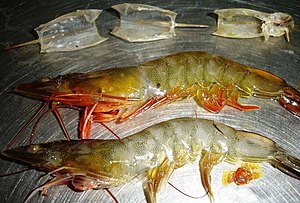Litopenaeus vannamei
| Litopenaeus vannamei | ||||||||||||
|---|---|---|---|---|---|---|---|---|---|---|---|---|

Litopenaeus vannamei |
||||||||||||
| Systematics | ||||||||||||
|
||||||||||||
| Scientific name | ||||||||||||
| Litopenaeus vannamei | ||||||||||||
| ( Boone , 1931) |
Litopenaeus vannamei ( Syn. Penaeus vannamei , English "White shrimp" or "Whiteleg shrimp", German "Weißbeingarnele") is a decipod crab from the Penaeidae family. This shrimp from the eastern Pacificis one of the most important farmed shrimp and is sold worldwide.
features
Litopenaeus vannamei reaches body lengths of 23 cm, the maximum length of the carapace is then around 9 cm. Females are usually larger than males of the same age because they grow faster. The entire body has a mostly translucent, milky color, but it can also vary depending on the nature of the soil, diet and water cloudiness.
The rostrum has seven to ten teeth on the back and two to four teeth on the abdomen. The thelycum of the females is rather open. In males, the petasma is symmetrical and half-open. The ridge running backwards from the rostrum does not extend all the way to the rear edge of the carapace. Compared to other species of the genus, the carapace is relatively short in relation to the abdomen and the tip of the rostrum points downwards.
Reproduction and development
Litopenaeus vannamei becomes sexually mature at an age of six to seven months . Males then weigh around 20 g, females around 28 g. Females weighing 30 to 45 g produce 100,000 to 250,000 eggs with a mean diameter of 0.22 mm. The Zoea larvae hatch around 16 hours after the eggs have been fertilized. Those are free swimming, show phototaxis and do not eat. During the larval stages Protozoea , Mysis and Postlarva, they remain planktonic and feed on phyto- and zooplankton. As a post larva, Litopenaeus vannamei changes into a benthic way of life and then feeds on detritus , worms, mussels and other crustaceans .
distribution and habitat
The natural distribution area of Litopenaeus vannamei is the Pacific coast from Sonora in the north via Central America to the Peruvian region of Tumbes in the south. There it lives at depths of 0 to 72 meters on muddy ground. Adults live more marine than benthons , while larvae can be found floating freely as plankton directly on the coast, mostly in estuaries , lagoons or mangrove forests . The water temperature is always over 20 ° C all year round.
Taxonomy
Lee Boone described the species as Penaeus vannamei in 1931 . He named it after Willard Gibbs Van Name , who bought the holotype at a fish market in Panama City in 1926. In 1969 Isabel Pérez Farfante divided the genus Penaeus into subgenus and introduced the shrimp as Penaeus (Litopenaeus) vannamei . After another revision of the genus by Isabel Pérez Farfante and B. Kensley in 1997, the subgenera were raised to the status of the genus, which is why the shrimp is now Litopenaeus . Of those, Litopenaeus vannamei is a type species .
use

The meat of the abdomen is considered a delicacy and is consumed worldwide. That is why Litopenaeus vannamei is both fished and grown in aquaculture . In 1999, 2,479 t were landed, of which 1,379 t were in El Salvador and 1,100 t in Ecuador. Between 2000 and 2010 the amount fished stagnated at around 2,000 t annually; in 2011 it was 3,072 t.
The first aquacultures emerged in South and Central America in the late 1970s . From the early 1980s, aquaculture was also established in the USA . The amount produced in America in 2004 was over 270,000 t. Since Litopenaeus vannamei is much easier to breed than the Penaeus monodon shrimp , breeding began at the beginning of the 21st century in Asia , especially in Thailand , China , Indonesia and Vietnam . In Asia, 1,116,000 tons were bred in 2004. According to the FAO , the amount of Litopenaeus vannamei cultured in 2011 was 2,877,542 t and was worth the equivalent of US $ 12,160,812,000.
The shrimp is usually sold frozen, with or without a cephalothorax . The main importers are the USA, followed by the EU and Japan .
Individual evidence
- ↑ a b c d e f Penaeus vannamei (Boone, 1931). In: Cultured Aquatic Species Information Program. Food and Agriculture Organization of the United Nations (FAO), accessed April 6, 2013 .
- ↑ a b Lee Boone: Anomuran, macruran Crustacea from Panama and Canal Zone . In: Bulletin of the American Museum of Natural History . tape 63 , no. 2 , 1931, p. 137–189 ( PDF, 3.9 MB [accessed April 6, 2013]).
- ↑ a b Penaeus vannamei (Boone, 1931). In: Species Fact Sheets. Food and Agriculture Organization of the United Nations (FAO), accessed April 6, 2013 .
- ^ I. Pérez Farfante: Western Atlantic shrimps of the genus Penaeus . In: Fishery Bulletin . tape 67 , 1969, p. 461-591 .
- ^ I. Pérez Farfante, B. Kensley: Penaeoid and sergestoid shrimps and prawns of the world. Keys and diagnoses for the families and genera . In: Mémoires du Muséum National d'Histoire naturelle . tape 175 , 1997, pp. 1-233 .
- ^ S. De Grave: Litopenaeus Pérez Farfante, 1969. In: World Register of Marine Species (WoRMS). 2012, accessed April 6, 2013 .
